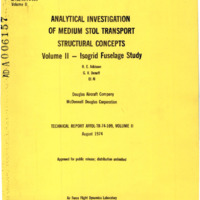-
Title
-
Analytical Investigation of Medium STOL Transport Structural Concepts: Volume II - Isogrid Fuselage Study
-
Description
-
Results of a study program to evaluate application of the isogrid structure concept to a medium STOL transport aircraft are presented. Isogrid is an integrally stiffened panel concept incorporating a triangular arrangement of the stiffening material which has been used successfully on space vehicle structure. The fuselage shell structure of the projected C-15 production airplane is used as the study (and baseline) component. The isogrid concept is evaluated for structural integrity, weight, manufacturing methods, applicability of NDI methods, production and life cycle costs, and aircraft performance payoffs. Structural integrity analyses of both the isogrid and the baseline concepts are based on a common set of requirements for ultimate strength, fatigue, and damage tolerance. Because of generally lower stress levels and a general absence of rivet and bolt holes in basic isogrid structure, fatigue and damage tolerance are of reduced criticality relative to baseline structure.
Aluminum materials (7475 plate selected) are the best choice for minimum production cost and weight for isogrid. The isogrid concept, as applied to the C-15 fuselage, however, is shown to be penalized in cost and weight by the following adverse configuration characteristics: (1) high wing and fuselage mounted landing gear which require heavy supporting frames; (2) significant areas of non-circular fuselage section which also require additional frames; (3) significant fuselage areas of double contour shape which result in increased forming costs; and, (4) low panel loadings which result in minimum gage machining constraints. The isogrid fuselage shell is approximately six percent heavier and 65 percent costlier to produce on a participating structure basis. Cost estimates are based on a 'bottom-up' detailed analysis approach for labor and materials. Applications of isogrid to other structural components on an engineering judgment basis are also considered.
-
Index Abstract
-
Not Available
-
Photo Quality
-
Not Needed
-
Report Number
-
AFFDL TR 74-109 Volume II
-
Index Price
-
$0.00
-
Report Availability
-
Full text available
-
Creator
-
Adkisson, R. E.
-
Deneff, G. V.
-
Extent
-
123
-
Corporate Author
-
Douglas Aircraft Company, McDonnell Douglas Corporation
-
Laboratory
-
Air Force Flight Dynamics Laboratory
-
Identifier
-
ADA006157
-
ADA006157
-
Corporate Report Number
-
MDC-J6625A
-
Contract
-
F33615-73-C-3049
-
DoD Project
-
1368
-
DoD Task
-
0212
-
Distribution Conflict
-
No
-
Access Rights
-
Approved for public release; distribution unlimited
-
Distribution Classification
-
1
-
Abstract
-
Results of a study program to evaluate application of the isogrid structure concept to a medium STOL transport aircraft are presented. Isogrid is an integrally stiffened panel concept incorporating a triangular arrangement of the stiffening material which has been used successfully on space vehicle structure. The fuselage shell structure of the projected C-15 production airplane is used as the study (and baseline) component. The isogrid concept is evaluated for structural integrity, weight, manufacturing methods, applicability of NDI methods, production and life cycle costs, and aircraft performance payoffs. Structural integrity analyses of both the isogrid and the baseline concepts are based on a common set of requirements for ultimate strength, fatigue, and damage tolerance. Because of generally lower stress levels and a general absence of rivet and bolt holes in basic isogrid structure, fatigue and damage tolerance are of reduced criticality relative to baseline structure.
Aluminum materials (7475 plate selected) are the best choice for minimum production cost and weight for isogrid. The isogrid concept, as applied to the C-15 fuselage, however, is shown to be penalized in cost and weight by the following adverse configuration characteristics: (1) high wing and fuselage mounted landing gear which require heavy supporting frames; (2) significant areas of non-circular fuselage section which also require additional frames; (3) significant fuselage areas of double contour shape which result in increased forming costs; and, (4) low panel loadings which result in minimum gage machining constraints. The isogrid fuselage shell is approximately six percent heavier and 65 percent costlier to produce on a participating structure basis. Cost estimates are based on a 'bottom-up' detailed analysis approach for labor and materials. Applications of isogrid to other structural components on an engineering judgment basis are also considered.
-
Publisher
-
Wright-Patterson Air Force Base, OH : Air Force Flight Dynamics Laboratory, Air Force Systems Command
-
Date
-
1974
-
Date Issued
-
1974-08
-
Date Modified
-
Scanned by request submitted 1/21/2020 by a private citizen (Private Citizen)
-
AD Number
-
ADA006157
-
DTIC Record Exists
-
Yes
-
Provenance
-
Bombardier/Aero
-
Type
-
report
-
Format
-
1 online resource (xii, 107 pages) : ill.
-
Subject
-
Fuselages
-
Structural Engineering
-
Short Takeoff Aircraft
-
Cost Analysis
-
Structural Properties
-
Stiffening
-
Fabrication
-
Configurations
